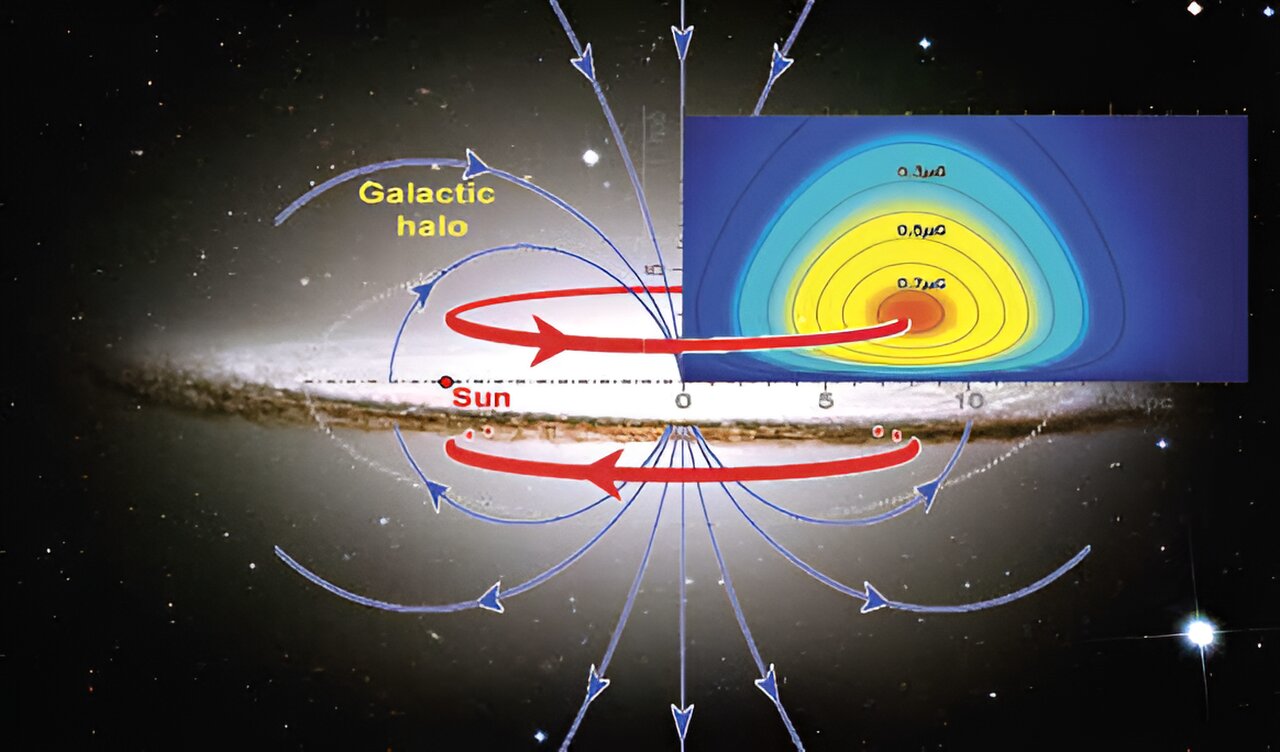Astronomers have unraveled a captivating secret hidden within the Milky Way’s halo – the existence of enormous magnetic toroids. These colossal structures, shaped like donuts, have eluded detection for decades, and their discovery sheds new light on the intricate workings of our galaxy.

Credit: NAOC
This groundbreaking research, published in The Astrophysical Journal by Dr. Xu Jun and Prof. Han Jinlin of the National Astronomical Observatories of the Chinese Academy of Sciences (NAOC), holds immense significance for our understanding of cosmic ray propagation and the very nature of magnetic fields within galaxies.
A Persistent Enigma: The Mystery of Cosmic Magnetism
The origin and evolution of magnetic fields throughout the cosmos have long baffled astronomers and astrophysicists. This enduring puzzle sits at the forefront of astronomical research, prompting major observatories like the Square Kilometer Array (SKA) to dedicate significant resources to its investigation. Determining the large-scale magnetic field structures within our Milky Way galaxy has proven to be a particularly formidable challenge for decades.
Pulsars as Beacons: Unveiling Galactic Magnetic Fields
Prof. Han Jinlin, a leading figure in this field of research, has spearheaded a long-term project focused on measuring the polarization of pulsars and their associated Faraday effects.
By meticulously analyzing this data, Prof. Han successfully mapped the magnetic field structures along the spiral arms of the Milky Way’s galactic disk in 1997. His groundbreaking discovery revealed a striking anti-symmetry in the Faraday effects observed across the celestial sphere. This asymmetry hinted at a toroidal magnetic field structure within the Milky Way’s halo, with the magnetic field reversing direction above and below the galactic plane.
The Quest for Scale: Unveiling the True Immensity of the Toroids
However, determining the size and magnetic field strength of these colossal toroids remained a daunting task. Astronomers initially suspected that the observed anti-symmetry might be an illusion, potentially arising solely from interstellar medium (ISM) in our Sun’s immediate vicinity. This is because pulsars and nearby radio-emitting objects tend to exhibit Faraday effects consistent with the observed anti-symmetry. The key challenge involved definitively proving the existence of these toroidal structures across the vast expanse of the galactic halo, extending far beyond the Sun’s surroundings.
A Novel Approach: Subtracting the Local Signal
Prof. Han spearheaded an innovative solution. He proposed meticulously measuring the Faraday rotation caused by the ISM in our Sun’s vicinity using data from a substantial sample of pulsars, including recent observations from the Five-hundred Aperture Spherical radio Telescope (FAST). By meticulously subtracting this contribution from the overall Faraday rotation measurements, the researchers could isolate the contribution from the galactic halo itself.
A Galactic Torus Revealed: Spanning Thousands of Light-Years
Dr. Xu Jun meticulously compiled Faraday rotation measurement data spanning the past three decades. Subsequent analysis revealed a remarkable finding – the anti-symmetry in Faraday rotation persisted across the entire celestial sphere, from the Milky Way’s center to its anti-center. This observation unequivocally confirms the existence of these colossal toroidal magnetic fields with a truly immense scale. The magnetic toroids span a staggering radius ranging from 6,000 to 50,000 light-years from the Milky Way’s center.
A New Chapter in Galactic Understanding
This groundbreaking research offers a paradigm shift in our understanding of the Milky Way’s physical processes. The discovery of these colossal magnetic toroids marks a significant milestone in the field of cosmic magnetic field research.
These findings will undoubtedly fuel further investigations into cosmic ray propagation within our galaxy and the very nature of magnetic fields on a grand scale. Prof. Han, Dr. Xu, and their team at NAOC have unveiled a captivating chapter in the ongoing saga of our Milky Way galaxy.
Their meticulous research not only sheds light on the structure of our galactic halo but also paves the way for a deeper understanding of the forces that govern the formation and evolution of galaxies throughout the cosmos.
The existence of these large-scale magnetic fields raises intriguing questions about their role in galactic dynamics and the life cycle of stars. Future studies may reveal how these magnetic giants interact with stellar winds, supernovae explosions, and the overall magnetic field of the Milky Way.
As telescopes like the SKA come online, astronomers will be able to probe these cosmic enigmas with even greater precision, bringing us ever closer to unraveling the mysteries that lie within the heart of our galaxy.



















